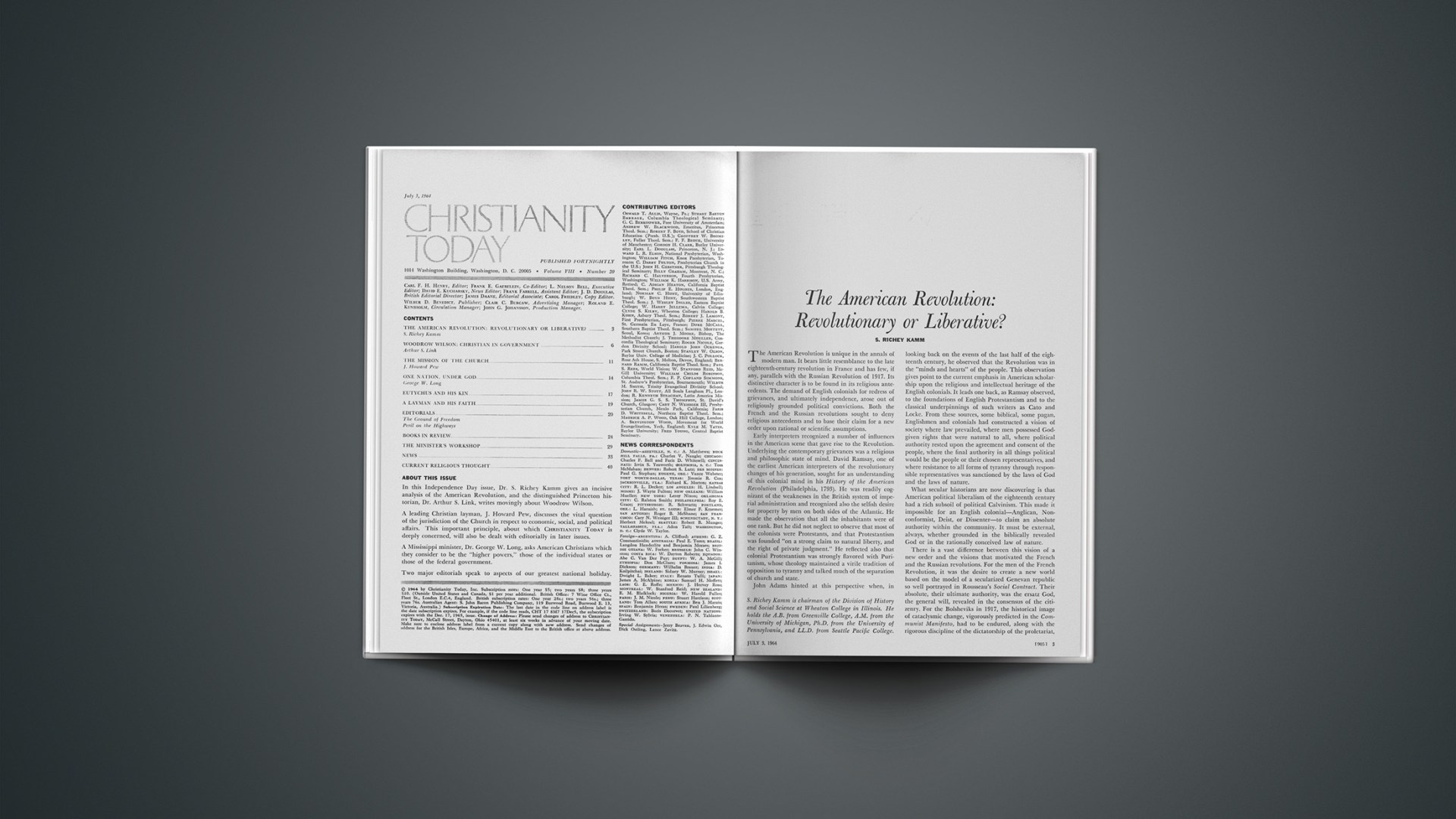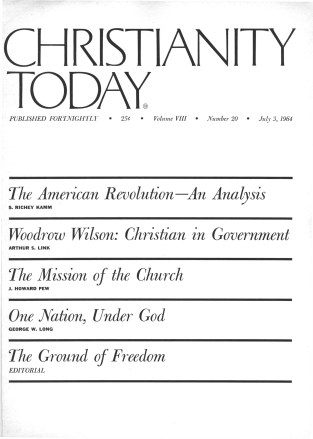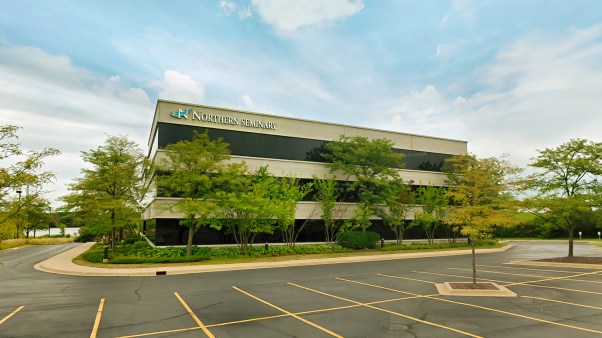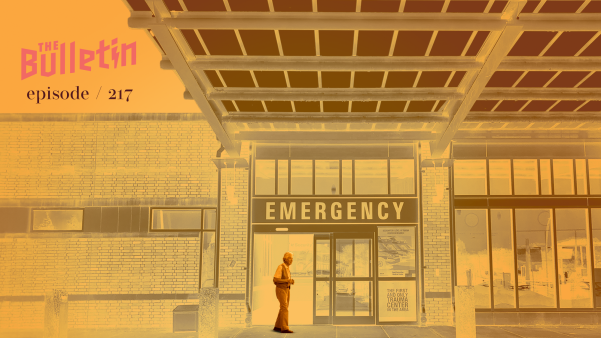The American Revolution is unique in the annals of modern man. It bears little resemblance to the late eighteenth-century revolution in France and has few, if any, parallels with the Russian Revolution of 1917. Its distinctive character is to be found in its religious antecedents. The demand of English colonials for redress of grievances, and ultimately independence, arose out of religiously grounded political convictions. Both the French and the Russian revolutions sought to deny religious antecedents and to base their claim for a new order upon rational or scientific assumptions.
Early interpreters recognized a number of influences in the American scene that gave rise to the Revolution. Underlying the contemporary grievances was a religious and philosophic state of mind. David Ramsay, one of the earliest American interpreters of the revolutionary changes of his generation, sought for an understanding of this colonial mind in his History of the American Revolution (Philadelphia, 1793). He was readily cognizant of the weaknesses in the British system of imperial administration and recognized also the selfish desire for property by men on both sides of the Atlantic. He made the observation that all the inhabitants were of one rank. But he did not neglect to observe that most of the colonists were Protestants, and that Protestantism was founded “on a strong claim to natural liberty, and the right of private judgment.” He reflected also that colonial Protestantism was strongly flavored with Puritanism, whose theology maintained a virile tradition of opposition to tyranny and talked much of the separation of church and state.
John Adams hinted at this perspective when, in looking back on the events of the last half of the eighteenth century, he observed that the Revolution was in the “minds and hearts” of the people. This observation gives point to the current emphasis in American scholarship upon the religious and intellectual heritage of the English colonials. It leads one back, as Ramsay observed, to the foundations of English Protestantism and to the classical underpinnings of such writers as Cato and Locke. From these sources, some biblical, some pagan, Englishmen and colonials had constructed a vision of society where law prevailed, where men possessed God-given rights that were natural to all, where political authority rested upon the agreement and consent of the people, where the final authority in all things political would be the people or their chosen representatives, and where resistance to all forms of tyranny through responsible representatives was sanctioned by the laws of God and the laws of nature.
What secular historians are now discovering is that American political liberalism of the eighteenth century had a rich subsoil of political Calvinism. This made it impossible for an English colonial—Anglican, Nonconformist, Deist, or Dissenter—to claim an absolute authority within the community. It must be external, always, whether grounded in the biblically revealed God or in the rationally conceived law of nature.
There is a vast difference between this vision of a new order and the visions that motivated the French and the Russian revolutions. For the men of the French Revolution, it was the desire to create a new world based on the model of a secularized Genevan republic so well portrayed in Rousseau’s Social Contract. Their absolute, their ultimate authority, was the ersatz God, the general will, revealed in the consensus of the citizenry. For the Bolsheviks in 1917, the historical image of cataclysmic change, vigorously predicted in the Communist Manifesto, had to be endured, along with the rigorous discipline of the dictatorship of the proletariat, before the new order of peace, harmony, and equality could be achieved. Their absolute was the dialectical materialism of universal history revealed in the class struggle. In neither case had the people concerned been involved in the development of the concept of a revolutionary state. For Frenchmen and for Russians the model was still a dream. To English colonials their model was a reality.
It is at this very point that the history of the American Revolution and other revolutions comes to the parting of the ways. The American resistance movement was in defense of a model of society already tried and found fruitful in the blessings of liberty. It was, as Edmund Burke put it, “a Revolution not made, but prevented,” for to the American colonial the growing power of the British imperial system threatened to destroy a way of life grounded in his religious convictions and substantiated by over a century of experience. For the Frenchman or the Russian, his revolution was a desperate reaching out for a model that was untried, a model that had few roots in and drew little sustenance from his cultural system.
It is this very feature of the American Revolution that enabled it to make a constructive contribution to mankind. The transition from monarchic government to republican institutions has frequently been attended by violence and continued instability. One would be foolish to disclaim the presence of any such phenomena on the American scene during the years 1774–89. But the fact remains that the psychology of the American political revolution is the biblical psychology of emancipation. It is the release to full responsibility of political institutions already grounded in the culture and practices of the people. Revolution is an act of liberation from the tyrannical hand of institutions already decadent because they have forsaken the time-honored foundations of political authority and are acting outside the law. This is in direct contrast to the cycle of movement in both the French and the Russian revolutions which liberated the people from one form of tyranny only to return them to a new form of tyranny through the tortuous pathway of organized terror.
Biblically Oriented Freedom
The American Revolution is predicated also upon a biblically oriented conception of freedom. Modern revolutionary movements offer an ambivalent model of freedom. They invite their devotees to throw off all traditional restraints in order to enjoy the freedom of life devoid of these restraints. But in so doing man becomes a slave, as Plato observed, and is psychologically prepared to endure a new tyranny in an effort to discover security and meaning for life. Both the French and the Russian revolutions encouraged anarchy in order that men might be “liberated” to the acceptance of the new tyranny that was necessary to restore order and to preserve life.
The American Revolution, being grounded upon a moral conception of freedom that found its clearest representation in the model of a man responding to the laws of God and the laws of men, had little occasion for the encouragement of anarchy and the inauguration of tyranny. The entire revolutionary movement is unique in its insistence upon the early establishment of legal institutions in the states, and the later inauguration of a federal government, which would guarantee the traditional liberties of responsible men. And because republican institutions both in theory and in practice provided the greatest guarantee of the perpetuation of this conception of freedom under the law, the new government pioneered in the use of the republican form both for the individual states and for the union of the states.
Ramsay’s observation that the colonials drew their ideas from the Christian religion and from pagan philosophy is representative of the multicultural system that prevailed in Colonial America. The Calvinistic insistence upon separation of state and church made way for continued freedom of expression, religious and philosophic. The American Revolution was far from a doctrinaire movement. Even though the men of that day were religiously minded, they enjoyed the freedom of drawing inspiration for their political system from Christian, classical, and even scientific sources. This is in direct contrast to both the French and the Russian revolutions, in which men were compelled to submit to a unicultural system based either on reason or on science, so-called.
Calm re-evaluation of the grievances enumerated in the Declaration of Independence may leave some historians in doubt as to the validity of the colonials’ cry of tyranny. But this same re-evaluation cannot erase the fear that the colonials experienced as they anticipated the destruction of the society so clearly portrayed in the Lockian language of the opening paragraphs of that instrument. Carl Bridenbaugh in his Mitre and Sceptre (Oxford, 1962) demonstrates that many colonial pastors saw in the continuous effort of the Anglican churchmen to establish the bishopric in America the destruction of that dream. The bishopric, to them, meant the establishment; the establishment, the union of church and state; the union of church and state, the suppression of a free expression in both religion and politics. The consecration of a bishop would mean the first step in the fulfillment of the entire imperial design. So it had been looked upon in New England in 1689; so it was looked upon in the Colonies in 1763.
Some pastors, such as Ezra Stiles of Connecticut, found themselves deeply moved by impending events but were loath to identify themselves with the leaders of political resistance to British rule. The events of 1774, however, as Edmund S. Morgan’s biography of Stiles, The Gentle Puritan (Yale, 1962), shows, forced this Congregational minister and others to join hands with the leaders of resistance and to become identified with the patriot cause.
The increasing pressure of British authority in the Colonies after 1774 drove both political and ecclesiastical leadership back to the Bible for inspiration and guidance. Here they found identification with ancient Israel as in times of duress the people had joined together before God to seek corporate forgiveness and the restoration of divine leadership. The call of the Second Continental Congress for “a day of publick humiliation, fasting, and prayer” on July 20, 1775, revived the biblical image of a “covenant” people. This symbolic act of worship, and the call to repentance that preceded it, gave a sense of identity and moral purpose to the growing resistance movement in the Colonies and a basis for national consensus. Without this invocation of divine assistance in all of the Colonies, says Perry Miller in his perceptive essay, “From the Covenant to the Revival,” in The Shaping of American Religion (Princeton, 1961), it is impossible to understand the morale of the English colonial revolutionary.
Two Further Questions
Two questions remain: why is the American Revolution frequently presented as a social revolution, and why did the American Revolution stimulate other peoples to abolish monarchy for republicanism?
There are evidences of social revolution during the American Revolution. The action of the various state governments in seizing the landed estates abandoned by fleeing Loyalists for sale and distribution initiated steps that led to the destruction of the last vestiges of landed feudalism. The abolition of primogeniture and entail in the settlement of estates and the disestablishment of the Anglican church in a number of states opened the door for greater equality of privilege and greater freedom of thought among the people.
Contemporary historical research reveals, however, that many of the landed estates were not broken up for distribution. Court action by legal descendants of the Loyalists often brought about restoration of title to seized lands under the terms of the Treaty of Paris of 1783. Changes in inheritance laws and in the laws providing public support to the church quite often merely sanctioned practices already initiated but not legally confirmed. The conviction is growing that the social revolution of this period was largely a confirmation of changes already inaugurated. Even the organization of national churches by Protestant groups simply confirmed the existence of religious bodies whose doctrine and polity reflected a century or more of independent development. The American Revolution is not a clear demonstration of the Marxian theory of class struggle. Neither is it a case study in peasant revolt. Rather, it is a pattern of social change derived largely from the principles of English Whiggery that sought to establish the principle of respect for the rights and property of the middle-class land-owner and entrepreneur.
The social revolution inherent in the principle of equality emblazoned in the Declaration of Independence is not discernible until at least a half-century later. It was the anti-slavery movement of the 1830s that focused attention upon this aspect of the American Revolution. The Abolitionists and other social reformers sought to make this principle a basic tenet of the American Constitution. It took the Civil War to secure its formal recognition in the Fourteenth Amendment, and Americans are wrestling still with its application.
The second question is to be answered in the light of the afterglow of the American Revolution. To the external observer, the great achievement of the Revolution was the establishment of republican institutions. This became identified with federalism, a system of power distribution that had been discussed and practiced in the British empire for almost a century. Political changes, which to some degree were revolutionary, were actually designed to preserve long-established privileges in politics, economics, and religion. The Constitution drafted in 1787 merely sanctioned a system of government already in operation. But this system, so well known to the Americans, was new to peoples in Europe and in Central and South America. To them the American Revolution became the symbol of political and economic liberty because it demonstrated that centralized monarchy and a unitary cultural and religious system were no longer essential to stable political institutions.
The religious foundations of the political and social system developed in the English Atlantic seaboard colonies gave a conservative cast to the entire revolutionary movement, when viewed from the perspective of the French and Russian revolutions. The solid achievements of the American Revolution in the field of politics and societal reorganization, all based on previous discussion and experience, ultimately became radical in character as they were projected abroad. The fact is that these same principles are still at work in the countries now coming to independent life in South and Southeast Asia, Africa, and the Middle East. The American Revolution has become the enduring revolution in spite of Communism’s claim to pre-emption in this field.
HEARTH SONG
When Francis made his canticle
In praise of all things beautiful,
Against the darkness of earth’s night
He saw shine the eternal light
Whose brightness burns in that saint’s song.…
O living flame as fair as strong
Dance on our hearths now, mock the gloom!
Frolic with shadows in this room:
So laying worldly terrors by
We talk with God, familiarly
As did His holy, humble friar,
And sing praise, too, of Brother Fire.
M. WHITCOMB HESS
S. Richey Kamm is chairman of the Division of History and Social Science at Wheaton College in Illinois. He holds the A.B. from Greenville College, A.M. from the University of Michigan, Ph.D. from the University of Pennsylvania, and LL.D. from Seattle Pacific College.










